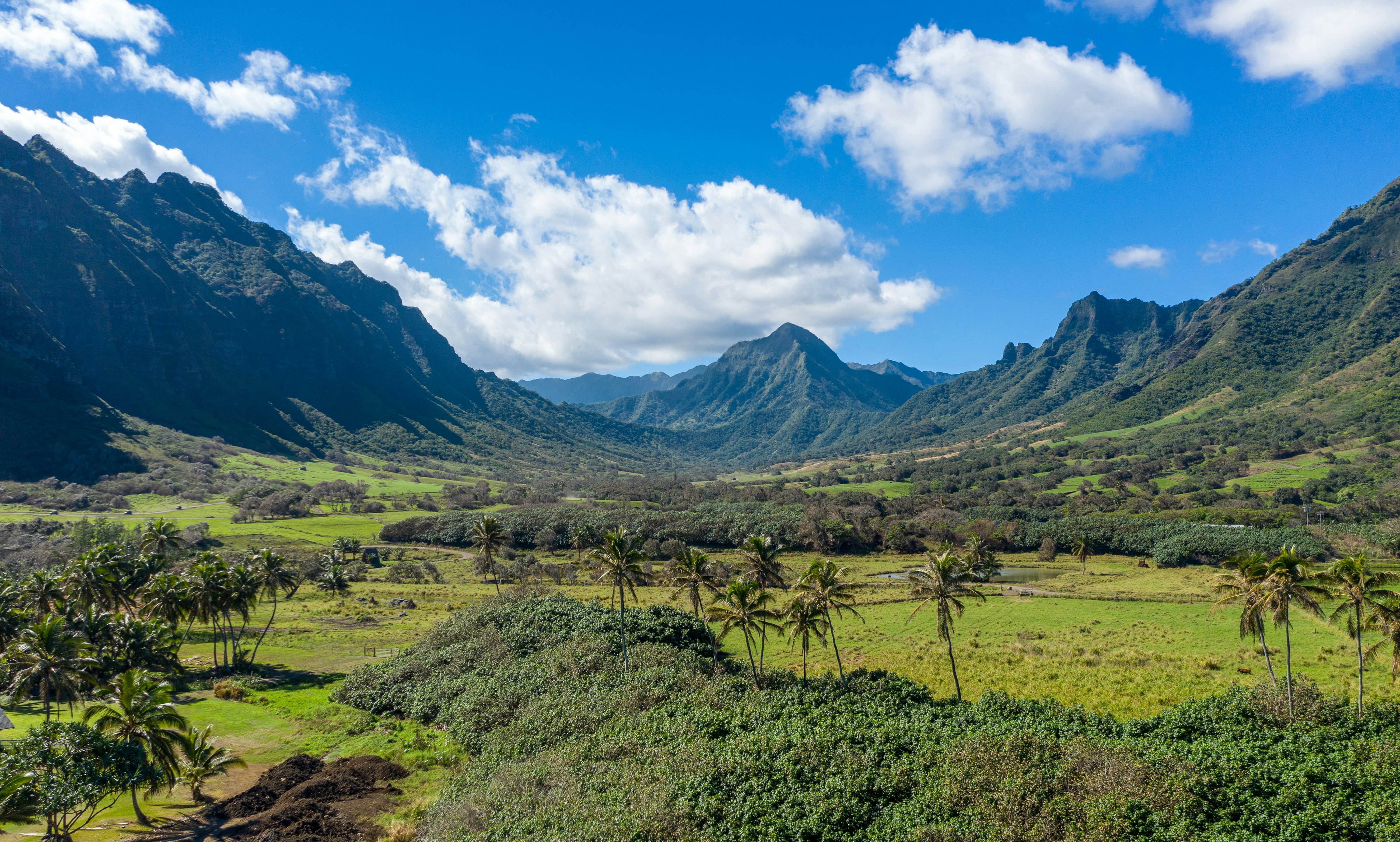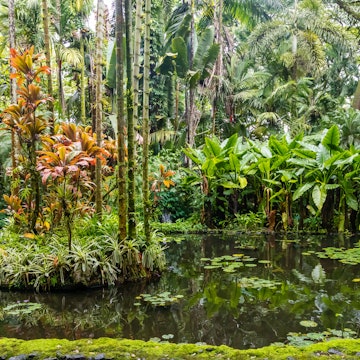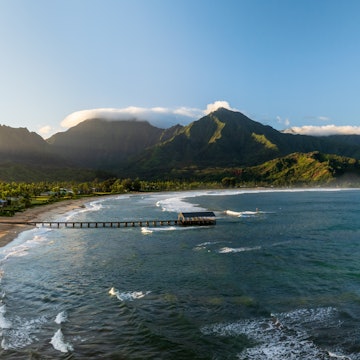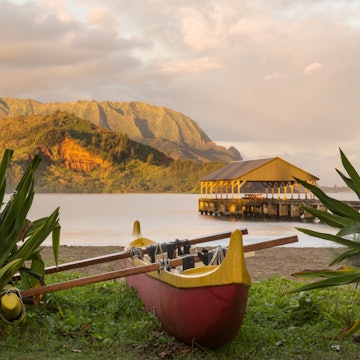

Plan your trip to Hawaii's Oʻahu this first-time guide © Onfokus / Getty Images
Welcome to Oʻahu, home to some of the most well-known natural landmarks in the world – from famed Waikiki Beach to towering Diamond Head to the surfable North Shore.
Known as a beautiful beach destination, this island is great for swimming, snorkeling, and surfing to your heart’s content. But beyond the sunny shorelines, Oʻahu has a wealth of greenery-filled hikes, internationally-inspired restaurants, and cultural landmarks for you to explore.
When should I go to Oʻahu?
Oʻahu truly is beautiful all year round. Summer brings sunny beach days, fall and spring bring ideal hiking weather, and winter brings surf competition-worthy waves. There really is no bad time to visit. That said, shoulder season – in this case, March to May and October to November – are arguably the best times to visit. The crowds are smaller, the prices are lower, and the weather is temperate.

How much time should I spend on Oʻahu?
Even though Oʻahu is a relatively small island, there are a whole lot of things to do. You’ll need four days at minimum to explore the highlights, including the restaurants of downtown Honolulu, the hiking trails of Hawaii Kai and the surf beaches of the North Shore.
Ideally, you’ll have time to stick around for a week or so, so you can explore beyond the must-sees. Add spots like the Koko Crater Botanical Garden in Hawaii Kai, the Byodo-In Temple in Kaneohe, and the Ko Olina lagoons to your extended itinerary.
Is it easy to get in and around Oʻahu?
There is one airport on Oʻahu, the Daniel K Inouye International Airport (HNL) in Honolulu. There are hundreds of flights every day from major domestic and international destinations, so you should have no problem making your way to the island by air. And that’s a good thing, because – with the exception of a few cruises – that’s really the only way to get to Oʻahu.
Once you’re on the island, you’ll have a couple of options for getting around. If you’re staying only in the tourist hubs of Waikiki or Ko Olina, you can likely get around on foot, with the occasional rideshare when necessary. That said, you’ll want to explore outside of these tourist hot spots, and the easiest and most convenient by far is via rental car. While it may cost a pretty penny, you’ll save yourself lots of time and have more flexibility.
Alternatively, you can go with The Bus, Oʻahu's public bus system. With the exception of a few hikes, beaches and farm stands, The Bus can get you to most major attractions on Oʻahu for just $7.50 per day or $30 per week. It just might take a little longer to reach your destination, but you can sit back, relax, and enjoy the sustainable ride.
Oʻahu has also recently opened Phase 1 of its Skyline, locally known as the rail. Despite the fact that it’s been years in the making, the Skyline isn’t all that helpful – you won’t want to rely on it as a form of transportation on your Oʻahu vacation.

Best places to visit in Oʻahu
Get to know Downtown Honolulu and Waikiki
Nearly every tourist to Oʻahu spends at least part of their trip in Downtown Honolulu and Waikiki. Spend your morning exploring the historic Native Hawaiian sites like ‘Iolani Palace, Ali‘iolani Hale, and Kawaiahaʻo Church, before spending the afternoon at the famed Waikiki Beach. Head to Sushi Sho for Japanese cuisine, Helena’s Hawaiian Food for authentic Hawaiian bites, or Bar Leather Apron for top-notch cocktails to round out your day. Make time to explore the best of Honolulu’s historic Chinatown.
Hit the hiking trails of Hawaii Kai
An underrated hiking hot spot, Hawaii Kai is home to some of the best trails on Oʻahu. Get a workout in on the 1000-step Koko Crater Trail, traverse through miles of greenery on the unbeatable Kuliouou Ridge Trail, or take it easy on the view-filled Makapu‘u Lighthouse Trail. When you need a bite to eat, the fusion brunch plates at Moena Cafe and the upscale internationally-inspired dishes at Roy’s will be waiting.
Work up a hunger while surfing the waves on the North Shore...
Spanning about 25 miles, the North Shore is a beach-filled haven. While the beaches are great for swimming and snorkeling in the summer, they turn into surf competition central with 20+-foot waves in the winter. There’s really no bad beach on the North Shore; however, the most beloved spots include Waimea Bay, Sunset Beach, and ‘Ehukai Beach Park. Please talk to the lifeguards at each beach to assess the ocean conditions before jumping in the water!
...then taste the flavors of the local food scene
Beyond the beaches, the North Shore is less-known for its foodie status. On one end, Haleiwa is filled with acai bowl joints galore. If you can only pick one, don’t miss the ones from Haleiwa Bowls. On the opposite end of the North Shore, you’ll find the little town of Kahuku, where you shouldn't miss farm-to-table plates at Kahuku Farms and the freshest seafood around at Ken’s Fresh Fish.
Explore Kailua's beaches, trails and markets
While the North Shore’s ocean conditions change drastically depending on the season, Kailua’s beaches stay relatively calm all year round. Start your morning with the 30-minute Lanikai Pillbox Hike for incredible ocean views, then venture down to Kailua Beach Park and Lanikai Beach for an afternoon of sun-tanning and swimming.
If one of Kailua’s many markets happens to be in full swing during your visit, you’ll want to add it to your itinerary. Check out the tropical fruit-filled Kailua Town Farmers Market, the artsy Lokahi Kailua Market, and the homeware-focused Aloha Home Market.

Take a nature tour around Kualoa Ranch
Nestled in the Ko‘olau Mountains, Kualoa Ranch offers a blend of engaging nature tours. While some focus on Native Hawaiian legends and history, others put the spotlight on the ranch’s movie fame – you make recognize it from the 1993-movie Jurassic Park.
My favorite thing to do on Oʻahu
Located on the East Side of Oʻahu, Kailua Beach Park and Lanikai Beach are an unbeatable pair. These two shorelines are home to the softest sand and the tealest waters on the island, so it’s no wonder that they’re regularly ranked as two of the best beaches in the world! What’s more, the ocean conditions at these two beaches are relatively consistent year-round, so you’re (nearly) always in for a day of calm waters and sunny skies. I can easily spend a full day at this beautiful beach. Just don’t forget to bring your reef-safe sunscreen.
How much money do I need for Oʻahu?
It’s safe to say that Oʻahu is pricey. Unless you plan on camping, be prepared to spend at least a couple hundred dollars per night on accommodations alone. On the flip side though, many of Oʻahu’s best activities – think beaches, hikes, and botanical gardens – are free to visit. Here are a few examples of what you can expect to pay during your time on Oʻahu:
A cup of Hawaiian coffee: $7
A poke bowl: $11–17
A (paid) nature hike: $5
Snorkel gear rental: $30/week
A surf lesson: $120
A lūʻau: $150
Car rental: $60–70 per day
Bus pass: $3/single fare ride
Learn the difference between “Hawaiian” and “local”
The term “Hawaiian” only applies to people who are Native Hawaiian – meaning indigenous to Hawai‘i – along with their culture, language, and history. In Hawaiian, the term is kanaka maoli (plural: kānaka maoli). “Local,” on the other hand, is used to indicate someone who is from Hawai‘i and not necessarily Native Hawaiian. Given that Native Hawaiian history is already filled with erasure, it’s important to not further that deletion by ensuring that the term “Hawaiian” only applies to people, places, and things that are truly Native Hawaiian.
Give the animals their space
Oʻahu is home to many wild animals – after all, the island is their home too! It’s not uncommon to encounter dolphins, boar, monk seals and sea turtles while hiking or snorkeling. But it’s important to give these animals their space. Since they are wild, they can behave unpredictably, especially when provoked. Instead, stay safe and try to keep at least a 10ft-distance from these amazing creatures.
As an additional note, both monk seals and Hawaiian green sea turtles are endangered species. As such, there are local laws in place to help protect them, and you can get charged with a hefty fine for getting too close.
Take local advice before diving into the ocean
One of the biggest draws of Oʻahu is the ocean, and swimming, snorkeling and surfing are often, quite rightly, at the top of visitor bucket lists. Oʻahu’s beaches are ideal for all of those activities. That said, it’s important to remember that the ocean is a powerful, potentially dangerous force. For your safety, you’ll want to educate yourself about each beach’s conditions before diving into the water. One of the best ways to do this is by chatting with the local lifeguards. They’ll be able to tell you everything you need to know – from wave size and rip currents to the best spots for snorkeling and surfing.
















